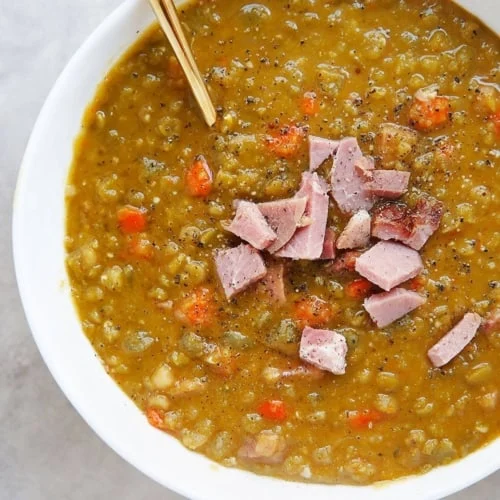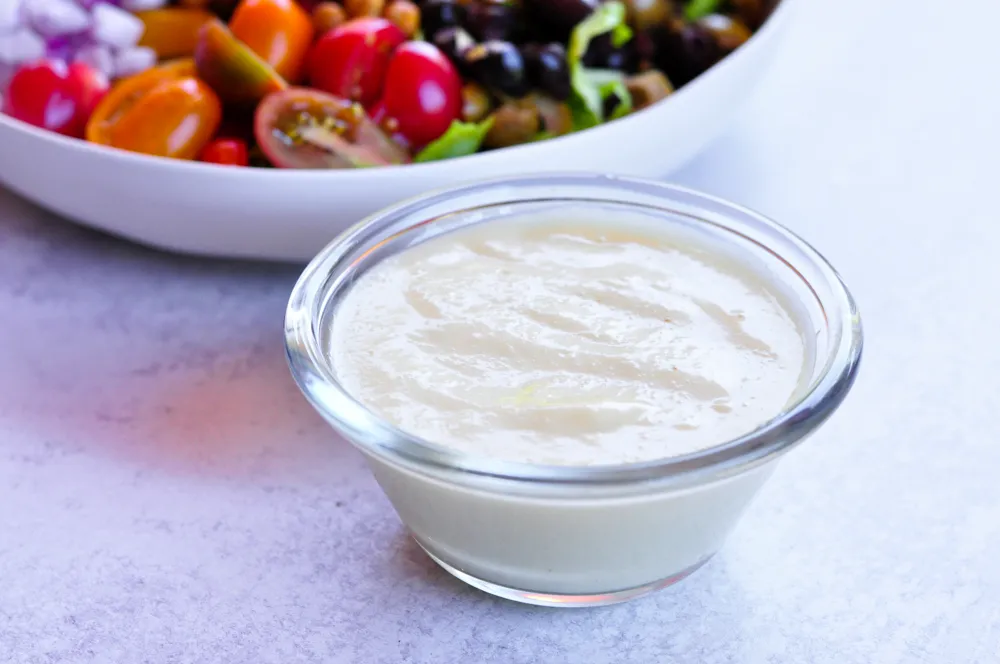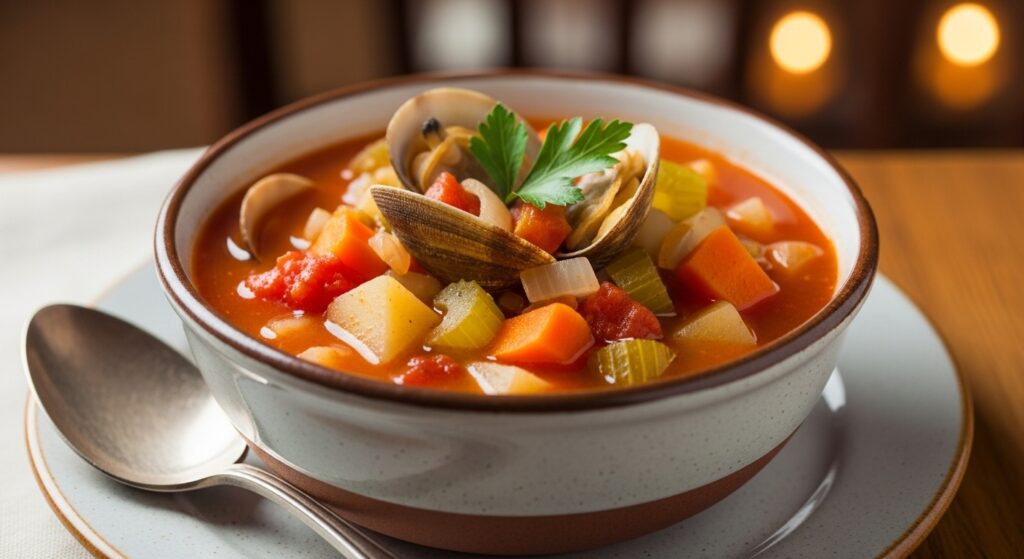If you’re craving a warm, hearty, and soul-soothing bowl of soup, nothing hits the spot quite like a classic clam chowder recipe.
Rich, creamy, and full of tender clams and savory vegetables, clam chowder has been a beloved comfort food for generations.
Whether you prefer the traditional New England style or want to add your own twist, this recipe is perfect for cozy dinners, family gatherings, or just treating yourself on a chilly day.
What is Clam Chowder?
Clam chowder is a thick, creamy soup made with clams, potatoes, onions, and celery, often flavored with bacon or salt pork.
The most famous variety is New England clam chowder, which uses milk or cream for its signature creamy texture.
Another popular style is Manhattan clam chowder, which has a tomato-based broth.
In this recipe, we’re focusing on the creamy New England version that’s rich, comforting, and absolutely delicious.
Also Check: How to Make Buffalo Wing Sauce
Ingredients You’ll Need
To make this homemade clam chowder, you’ll need simple, pantry-friendly ingredients:
-
4 slices bacon – adds a smoky, savory flavor
-
1 medium onion, diced
-
2 ribs celery, diced
-
3 medium potatoes, peeled and diced into small cubes
-
2 cups bottled clam juice
-
2 (6.5-ounce) cans chopped clams, undrained
-
2 cups half-and-half (or heavy cream for a richer chowder)
-
2 tablespoons all-purpose flour
-
2 tablespoons butter
-
1 bay leaf
-
Salt and pepper, to taste
-
Fresh parsley, chopped (optional, for garnish)
Step-by-Step Instructions
1. Cook the Bacon

Place a large, heavy-bottomed pot or Dutch oven over medium heat. Lay the bacon slices flat in the pan without overlapping so they cook evenly.
Let the bacon render its fat slowly, turning occasionally, until it becomes deep golden and crispy, about 5–7 minutes.
Using a slotted spoon, carefully transfer the cooked bacon to a plate lined with paper towels to drain.
Reserve about 2 tablespoons of the rendered bacon fat in the pot for flavor — this will be the base for sautéing your vegetables and will give the chowder its signature smoky undertone.
The rest of the bacon fat can be discarded or saved for other recipes.
2. Sauté the Vegetables
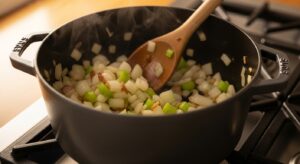
With the reserved bacon drippings still warm in the pot, add the diced onion and celery. Stir to coat them in the fat, which will help them soften and release their natural sweetness.
Cook over medium heat for 4–5 minutes, stirring occasionally to prevent burning, until the onions turn translucent and the celery softens slightly.
At this stage, the aroma should be rich and savory — the perfect foundation for your chowder.
You can also add a pinch of salt here to draw out extra moisture from the vegetables.
Read More: How to Make Garlic Sauce at Home
3. Add Potatoes and Clam Juice
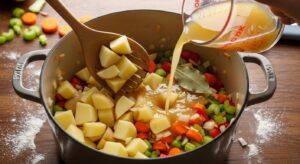
Once the vegetables are softened, add the diced potatoes to the pot, stirring so each piece gets a light coating of the bacon-flavored oil.
This quick toss helps lock in flavor before simmering. Pour in the clam juice, ensuring the potatoes are just covered — this allows them to absorb the briny, ocean-like flavor as they cook.
Drop in the bay leaf, which will infuse the broth with subtle herbal notes.
Turn the heat to medium-high and bring the mixture to a gentle boil. Once it boils, immediately lower the heat to a simmer and cook for about 10–12 minutes, or until the potatoes are tender when pierced with a fork.
Avoid overcooking here, as overly soft potatoes can break down too much in the chowder.
4. Make the Creamy Base
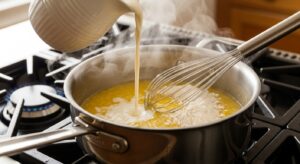
While the potatoes simmer, prepare your creamy base in a separate saucepan. Melt the butter over medium heat until it starts to foam slightly.
Sprinkle in the flour, whisking continuously to create a smooth paste known as a roux. This step is essential for thickening the chowder later.
Continue whisking for about 1–2 minutes to cook off the raw flour taste — the roux should take on a pale golden color.
Slowly pour in the half-and-half (or heavy cream if you want an extra-luxurious texture), whisking constantly to prevent lumps.
Continue whisking until the mixture thickens slightly, about 3–5 minutes. Keep the heat on low to medium to prevent scorching.
5. Combine Everything
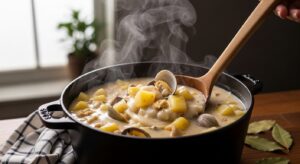
Once the potatoes are tender and the creamy base is ready, remove the bay leaf from the potato mixture. Gently pour the creamy roux mixture into the main pot, stirring to combine everything into a luscious, thick soup.
Add the canned clams, including their natural juices, which will deepen the seafood flavor. Stir gently to avoid breaking apart the clam pieces. Let the chowder heat through over low heat for another 5 minutes.
This step is important — you want the flavors to meld together without boiling, as boiling can cause the cream to separate and the clams to turn rubbery.
Read More: Easy Ways to Make Creamy Pesto Sauce
6. Season and Serve
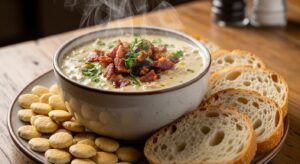
Taste your chowder and season it with salt and freshly ground black pepper to your preference.
Remember that clam juice is naturally salty, so add salt gradually to avoid over-seasoning.
Once you’re satisfied with the flavor, ladle the hot chowder into bowls. Top each serving with the crumbled bacon you cooked earlier and a sprinkle of fresh parsley for a pop of color and freshness.
Serve immediately with oyster crackers, crusty sourdough bread, or a side salad for a complete meal.
For an extra indulgent touch, drizzle a small amount of melted butter over each bowl right before serving.
Tips for the Best Clam Chowder
-
Don’t overcook the clams – they can become tough. Add them at the end for the best texture.
-
Use fresh clams if possible – canned clams are convenient, but fresh steamed clams elevate the flavor.
-
For extra depth, add a splash of white wine when cooking the vegetables.
-
Make it thicker by adding more roux or mashing some of the potatoes in the pot.
What to Serve with Clam Chowder
Clam chowder is filling on its own, but it pairs wonderfully with:
-
Oyster crackers
-
Garlic bread or sourdough
-
A fresh garden salad
-
Cornbread for a sweet-savory combo
Storage and Reheating
Store leftovers in an airtight container in the refrigerator for up to 3 days.
Reheat gently on the stove over low heat, adding a splash of milk or cream if needed. Avoid boiling to prevent separation.
Final Thoughts
This clam chowder recipe is the perfect blend of creamy, savory, and comforting flavors.
It’s easy to make, satisfying to eat, and guaranteed to warm you up from the inside out.
Whether you’re cooking for family, friends, or just yourself, this recipe will quickly become a go-to favorite.
Also Check: How to Make Garlic Butter Sauce
Things to Avoid When Making Clam Chowder
Even though clam chowder is a simple comfort food, a few missteps can easily affect the final flavor and texture.
Keep these tips in mind to make sure your chowder turns out rich, creamy, and delicious every time:
-
Overcooking the Clams – Clams cook very quickly, and leaving them on the heat too long will make them tough and rubbery. Always add them toward the end of cooking and heat just until warmed through.
-
Letting the Cream Boil – Boiling dairy can cause it to curdle, giving your chowder an unpleasant texture. Keep the heat low once the cream or half-and-half is added, and never let it reach a rapid boil.
-
Using Too Much Salt Early On – Clam juice and bacon are naturally salty, so avoid adding too much salt at the start. Taste the chowder near the end and season gradually to avoid overpowering the flavors.
-
Skipping the Roux Step – The roux is key for creating a thick, velvety texture. If you skip it or rush the process, your chowder may turn out thin or have a raw flour taste.
-
Overcooking the Potatoes – Potatoes that are too soft will break apart and make the chowder overly starchy. Simmer them just until fork-tender, then move on to the next step.
-
Forgetting to Stir Gently – Stirring too vigorously after adding the potatoes and clams can cause them to break apart. Gentle stirring keeps the chowder chunky and hearty.
-
Not Using Fresh Ingredients – While canned clams are convenient, using fresh clams, fresh herbs, and good-quality cream can elevate your chowder from good to restaurant-worthy.
